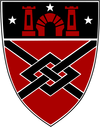
Phi Kappa Psi (ΦΚΨ), commonly known as Phi Psi, is an American collegiate social fraternity that was founded at Jefferson College in Canonsburg, Pennsylvania in 1852. The fraternity has over ninety chapters at accredited four-year colleges and universities throughout the United States. More than 179,000 men have been initiated into Phi Kappa Psi since its founding. Phi Kappa Psi and Phi Gamma Delta, both founded at the same college, form the Jefferson Duo.

Seton Hall University (SHU) is a private Roman Catholic research university in South Orange, New Jersey. Founded in 1856 by then-Bishop James Roosevelt Bayley and named after his aunt, Saint Elizabeth Ann Seton, Seton Hall is the oldest diocesan university in the United States.
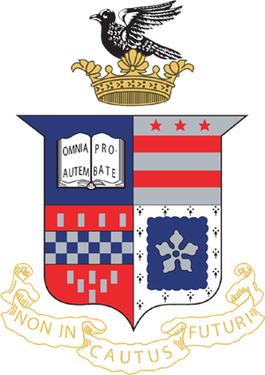
Washington and Lee University is a private liberal arts college in Lexington, Virginia. Established in 1749 as Augusta Academy, it is among the oldest institutions of higher learning in the United States.

Lock Haven University of Pennsylvania (LHU) is a public university in Lock Haven, Pennsylvania. It is part of the Pennsylvania State System of Higher Education. The main campus consists of 200 acres (81 ha) and the branch campus covers 12.9 acres (5.2 ha). It offers 69 undergraduate programs and 4 graduate programs.

Washington & Jefferson College is a private liberal arts college in Washington, Pennsylvania. The college traces its origin to three log cabin colleges in Washington County established by three Presbyterian missionaries to the American frontier in the 1780s: John McMillan, Thaddeus Dod, and Joseph Smith. These early schools eventually grew into two competing academies, with Jefferson College located in Canonsburg and Washington College located in Washington. The two colleges merged in 1865 to form Washington & Jefferson College. The 60 acre (0.2 km2) campus has more than 40 buildings, with the oldest dating to 1793.
Dartmouth College is host to many fraternities and sororities, and a significant percentage of the undergraduate student body is active in Greek life. In 2005, the school stated that 1,785 students were members of a fraternity, sorority, or gender-inclusive Greek house, comprising about 43 percent of all students, or about 60 percent of the eligible student body. Greek organizations at Dartmouth provide both social and residential opportunities for students and are the only single-sex residential option on campus. Greek organizations at Dartmouth do not provide dining options, as regular meal service has been banned in Greek houses since 1909.
There are many collegiate secret societies in North America. They vary greatly in their level of secrecy and the degree of independence from their universities. A collegiate secret society makes a significant effort to keep affairs, membership rolls, signs of recognition, initiation, or other aspects secret from the public.
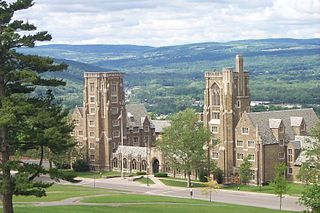
West Campus is a residential section of Cornell University main campus in Ithaca, New York. It is bounded roughly by Fall Creek gorge to the north, West Avenue and Libe Slope to the east, Cascadilla gorge and the Ithaca City Cemetery to the south, and University Avenue and Lake Street to the west. It now primarily houses transfer students, second year students, and upperclassmen.

Boyd Crumrine Patterson was an American mathematician and the ninth president of Washington & Jefferson College.
The term Triad is used to designate certain historic groupings of seminal college fraternities in North America.
The campus of Northwestern University encompasses two campuses in Evanston, Illinois and Chicago, Illinois, United States. There is an additional campus located in Doha, Qatar which offers bachelor's and master's degrees. The original Evanston campus has witnessed approximately 150 buildings rise on its 240 acres (0.97 km2) since the first building opened in 1855. The downtown Chicago campus of approximately 25 acres (100,000 m2) is home to the schools of medicine and law was purchased and constructed in the 1920s and 1930s.

The residence hall system at the University of Central Florida in Orlando, Florida is administered by the Department of Housing and Residence Life. As of 2011, the system offers just under 6,500 beds on its main campus within five housing communities, 400 beds at the Rosen College of Hospitality Management, and 3,750 beds in university-affiliated housing.

McMillan Hall is a building on the campus of Washington & Jefferson College in Washington, Pennsylvania, United States. Built in 1793, it is the only surviving building from Washington Academy. It is the eighth-oldest academic building in the United States that is still in use for its original academic purpose and is the oldest surviving college building west of the Allegheny Mountains.

The Old Gym is a historic building at Washington & Jefferson College in Washington, Pennsylvania. It currently houses a modern exercise facility featuring cardiovascular, resistance, and strength-training equipment. The building also features a three-lane indoor track suspended above the main floor.

Over 8,000 undergraduate and graduate students live in campus housing at the University of North Carolina at Chapel Hill during a regular school year. Forty residence halls are grouped into 16 residential communities across campus.
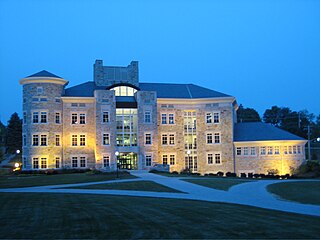
The Howard J. Burnett Center, also known as The Burnett Center, is an academic building on the campus of Washington & Jefferson College. This building, named after former President Howard J. Burnett, was completed in 2001 at a cost of $12.8 million. It houses the Departments of Economics and Business, Modern Languages, and Education.
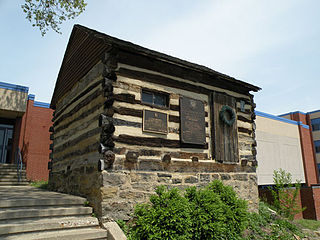
John McMillan's Log School is a landmark log building in Canonsburg, Pennsylvania that was the site of John McMillan's frontier Latin school during the 1780s. It is a symbol of Canonsburg and Canonsburg's educational tradition. In 1930, The Pittsburgh Press said that the building was "viewed by the pioneers with even more reverence than Pittsburgh now view the towering Cathedral of Learning in Oakland." It is one of the oldest buildings in Western Pennsylvania. It is the "oldest educational building west of the Allegheny Mountains."

Washington & Jefferson College is host to 8 Greek organizations and a significant percentage of the undergraduate student body is active in Greek life. With 43% of women and 40% of men of the student body participating in "greek life," fraternities and sororities play a significant role in student life at W&J. The Princeton Review named Washington & Jefferson College 12th on their 2010 list of "Major Frat and Sorority Scene" in the United States. As of 2021, the Office of Fraternity & Sorority Life recognized 4 fraternities, Alpha Tau Omega, Beta Theta Pi, Delta Tau Delta, and Phi Kappa Psi, and four sororities, Delta Gamma, Kappa Alpha Theta, Kappa Kappa Gamma, and Pi Beta Phi. The fraternities are governed by a local Interfraternal Council and the sororities are governed by a local Panhellenic Council, while the Greek Judiciary manages broad policy violations at the chapter-level. All Greek organizations occupy College-owned houses on Chestnut Street on campus. All members of fraternities and sororities must pay the $100 "Greek Membership Fee," a levy designed to fund leadership seminars and other educational events for Greeks.


















